In the works for over a decade and now expected to take another 10 to 15 years to complete, the key approvals for the redevelopment of San Francisco’s 28-acre Pier 70 site, the height limits for which were increased by voters back in 2014, could be approved by San Francisco’s Planning Commission next week.
Depending upon whether Forest City decides to maximize the Central Waterfront site for residential or commercial use, the Pier 70 Project will yield between 1,645 and 3,025 residential units; between 1.1 and 2.3 million square feet of commercial/office space; and up to 519,000 square feet of space for retail, light industrial and arts uses along with up to 3,345 off-street parking spaces and nine acres of open space.
New buildings will range from 50 to 90 feet in height, intermingled with a few rehabilitated structures across the site.
And assuming the project’s Draft Environmental Impact Report is certified, a Pier 70 Special Use District is adopted, and the project’s Design for Development and Develop Agreement are approved, the ground could be broken for the waterfront development next year.
The redevelopment of Pier 70’s Historic Core, which is a separate six-acre project, is already underway.
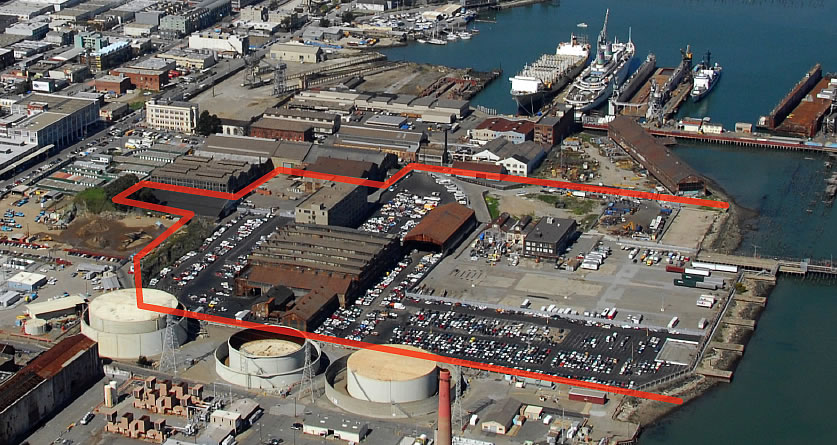
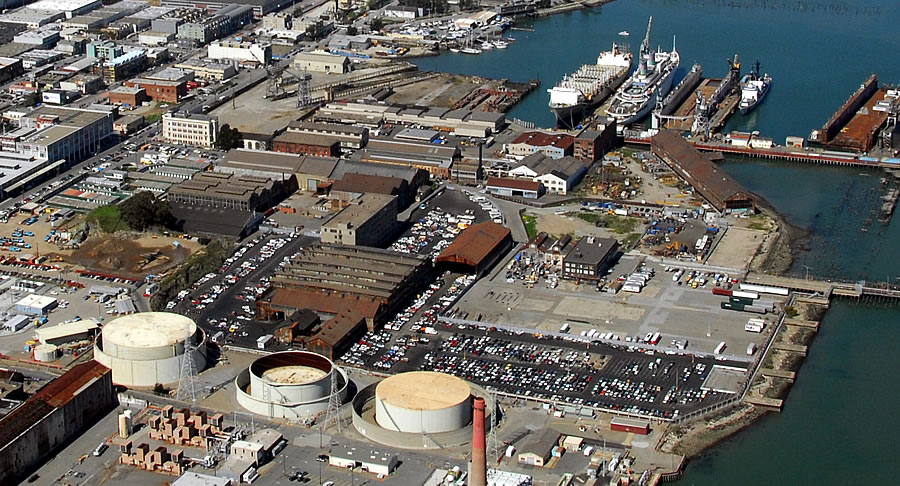
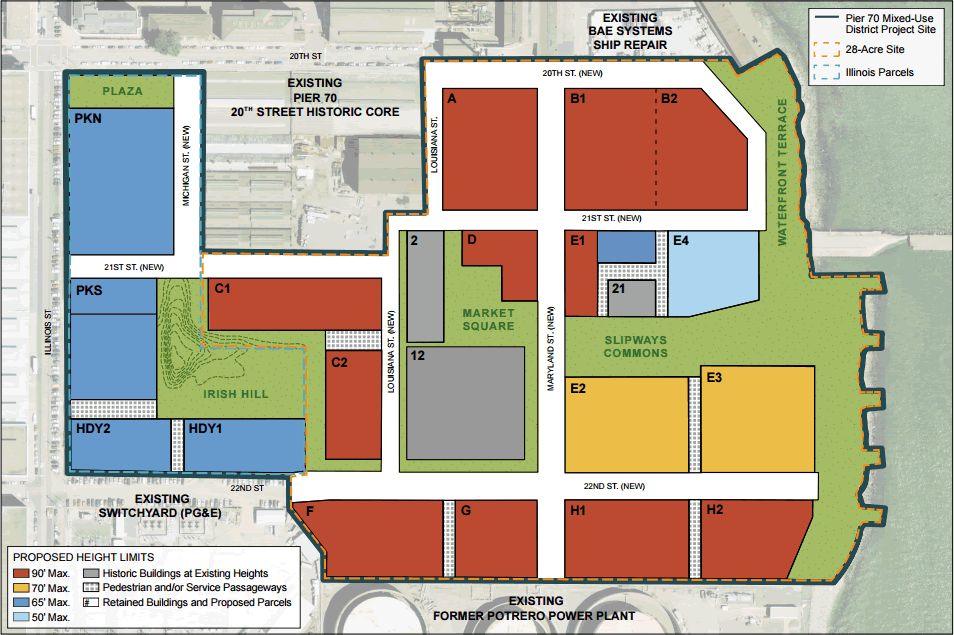
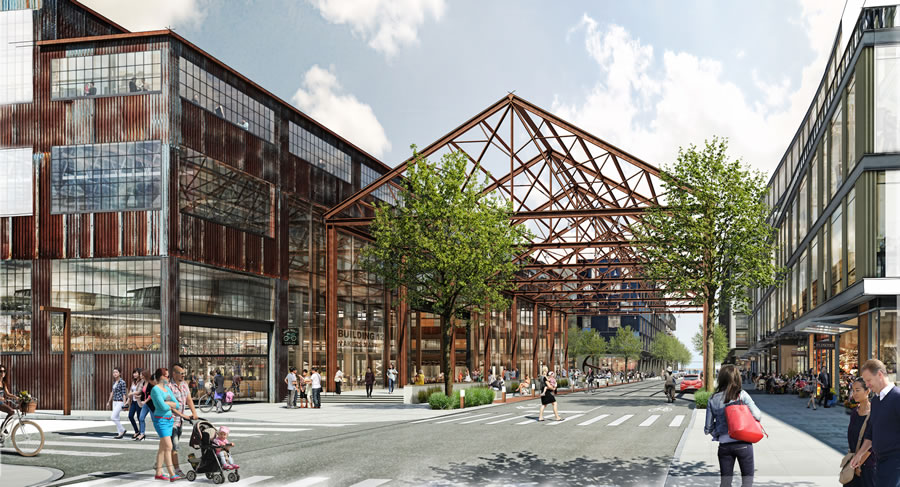
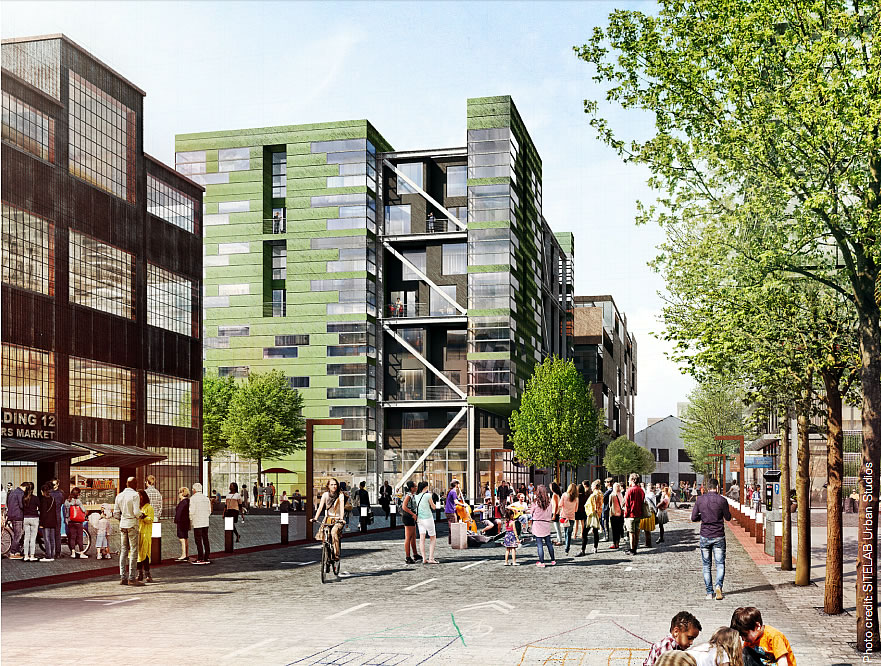
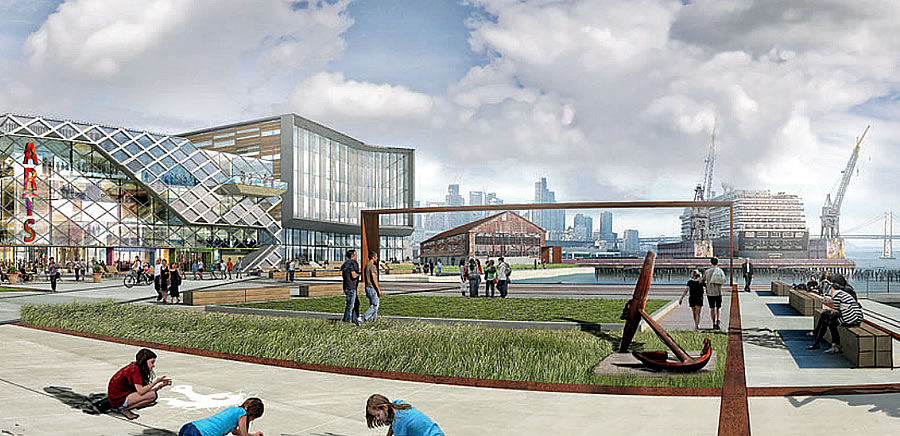
Not that this should be turned into a political forum, but [this is] an interesting article pertaining to height limits, which if I’m reading it correctly (and it’s still ongoing : my apologies if it’s been settled and I missed it), could – depending on outcome – mean that pesky thing called “voter approval” might become a memory and presumably we might have many more of these. Or not.
The city doesn’t need more office space. Jobs are leaving, the labor force has peaked and Lennar is very quiet on it’s effort to lease space in its CP office development. As in few if any takers. That said, the City needs to demand the most residential units/least office space in this development. 2.3 million feet works out to about 10K workers – with only 1645 residential units there would be a huge jobs/housing imbalance adding to the housing and commute crisis. Even the residential friendly proposal option has an imbalance, but the ratio is close to the 1/1 which should be the requirement in the City going forward.
Jobs are leaving but office space rents are as high as it has even been. Genuine question, why?
Actually, per the last SS report, the office vacancy rate is creeping up and is now near its historic norm. That itself is not the sign of a strong office market. The telling numbers will be absorption for the 3rd and 4th quarters. it’s been negative for two quarters now which has not happened since at least 2010.
Should have added – vacancy rates are a leading indicator of rents. If the negative absorption continues this quarter and next, rents will start to fall.
Despite Dave’s comments, no one has shown “jobs are leaving”; in fact the latest thread on jobs today showed they are essentially at an all time high (tho as pointed out that was “employed people”, not jobs per se, but no one AFAIK has shown the latter decreasing). And rents appear stagnant: they grew Q over Q, but are lower than they were last year; so you are correct they “are as high as ever” but then so are jobs.
Key sentences from the link you posted:
San Francisco experienced its second quarter of occupancy loss, measuring 227,000 square feet of negative net absorption. Contributing to this negative net absorption for the quarter is a combination of the lack of significant move-ins as well as a few companies rightsizing their footprints in the City.
Key words – lack of significant move-ins. Large floor plate companies are not relocating to SF and won’t. They are leaving as with Blue Shield next year. 2K plus workers. UCSF is rumored to be moving administrative functions to Oakland. Schwab pulled everyone out.
It’s not about a crystal ball, it’s about looking at all sorts of trends/metrics here and in other metros – such as my beloved Seattle and I thank you for so referencing – and drawing one’s own conclusion(s). As an investor I put my money where my mouth is – which is not SF.
Is that the paragraph above:
The San Francisco investment market remains one of the most sought-after markets both nationally and internationally. … The second half of 2017 is forecasted to be strong with additional Class A & Class B office assets coming to market. A renewed mid-year investment outlook should help San Francisco achieve total investment volume inline with recent prior years?
🙂
Honesty, you’re preaching to the choir here, but I think you’re rushing the Apocalypse a bit: SF’s – and California’s in general – real problems are long-term obligations that are being un-/underfunded not an imminent real estate collapse…though that wouldn’t help.
@Notcom – I’m hardly preaching Apocalypse or a RE collapse. Not at all, never – I “preach” a flattening in RE prices here and future appreciation (5 – 10 years) more or less tracking the national average. Take that to the bank. As to California – the tax situation is a mess – Reno is booming and has a housing crisis as in shortage To a large degree because California companies are putting huge flags down there and moving workers – do a google.
[Editor’s Note: And with that, it’s back to Pier 70 in specific or over here to continue the general office market debate…]
This will be a positive development in this area and look forward to its completion.
I agree, I like almost everything about this and it will a great addition to the waterfront. Hard to imagine something taking 10-15 years to complete but at least it’s budgeted beyond current/traditional real estate cycles. I just hope with all of this waterfront development, they leave a few historical morsels in tact like the Ramp.
The Ramp is not only protected, its outdoor seating area is being expanded in conjunction with the Crane Cove Park project just to the north of the Pier 70 historic area project on Illinois Street.
[Editor’s Note: New Timing for San Francisco’s Crane Cove Park and Shoreline.]
Great to read The Ramp is safe. Love that place…
San Francisco is so backwards. In 10-15 yrs, most of what people are commenting about will be largely irrelevant. Numerous cities in the US are expanding and growing faster and more efficiently. By the time this lame pier is built, these other cities will have overtaken the city in terms of job growth, oppty, and appeal. In fact, it will take Manhattan less time to build an entire new neighborhood (Hudson Yards). This likely useless pier is just little too late. All the piers should have had active projects built and completed well in advance of current necessity. It’s mind boggling how little gets done in San Francisco.
You know, this isn’t a competition. The skies over San Francisco don’t darken because of something done in NY. Other cities are allowed to exist and do their thing without “eclipsing” this city.
Unless, of course, you personally need to live in a city with the tallest building, or the most population, or whatever. In which case, you could either grow up a little bit, or move, as San Francisco was never the right city for you. Move to Tokyo, or Moscow, or NY, or London, or some other city you thing has the biggest X to make you feel big.
San Francisco is 7 by 7 miles with a great mediterranean climate, beautiful historical buildings, and a generally relaxed atmosphere. It’s walkable, is right on the water and close to Muir woods, with beautiful bridges, lots of fine dining options and some nice cultural institutions. It has never had the tallest buildings in the world, the most famous symphony in the world, the largest population, or the highest income, nor has it ever aspired to have any of these things. It is a pleasant, livable city in which people care more about their own quality of life than alleviating whatever size-based insecurities you may have.
Actually it isn’t a personal preference — it is about making things run efficiently and better. I agree with the Jeremy about how other cities (and even previous third world countries) surpassing SF and the U.S. in general because of our inability to change what isn’t working.
I’ve actually had one public interest tenant’s attorney try to make her convincing argument that if people didn’t like the way the SF homeless are in the streets, people should just move to another city. It is indicative of the type of inability to fix current problems including unfunded or underfunded public pensions (which other investors will see as a potential Illinois or Chicago waiting to happen in 10-20 yrs.)
We should be cutting pensions or requiring city workers to be aged 67 before receiving benefits. Working 25 yrs until age 47 and being able to retire on taxpayers dime is a joke
and…you can’t retire that early. It’s 53 for “miscellaneous” (non-safety) employees with 20 years of service, 60 with 10 years of service, or 65 with any years of service. Also, credit is figured as service years X age factor X ending salary (last 3 year average). The age factor increases with age, from 1% at 53 to 2.3% at 65 or over. So if someone retires with a 100K salary at 53 after 20 years of service, they only make 20K per year. SF is actually quite conservative with their retirement plans, and clearly incents people to stick around into their 60s.
> “if people didn’t like the way the SF homeless are in the streets, people should just move to another city.”
Haha. This may be the most SF sentiment ever. The people who are paying (dearly) to live there deserve to be there less, apparently.
On the other hand, SF government being supremely unwilling and too incompetent to fix the problem actually makes this excellent advice, which I took 🙂
Agree with all, except historical buildings. Sf is a new city with little architecture of historic significance
Yeah totally agree with Spencer’s assertion that San Francisco, incorporated in April of 1850 and founded in 1776, “…is a new city with little architecture of historic significance.” Uh huh. Yep.
And while we have consensus, we really should float a petition to rip down The Haas–Lilienthal House to let Natoma Architects build more of their Neobrutalist slabs of cast concrete.
Yes. Being incorporated in 1850 makes SF a very new city. Other cities mentioned in this very thread are NY, Tokyo and London. How many people did each of these cities have in 1850?
Yes and no. There are worthy buildings in SF in terms of preservation. There are other buildings such as auto repair shops that have no historic worth. An inferiority complex on the part of SF? SF generally does not have historic buildings – it is what it is.
For reasons – it’s relatively young age and seismic issues. The largest collection of pre-1900 buildings on the West Coast lies in the Willamette Valley between Eugene and Salem. Well worth a trip if you are into historic structures. Yet even the Willamette Valley stretch of historic buildings does not take itself too seriously and does not claim to be anything more than the largest collection on the West Coast. The Willamette Valley has nothing on areas East of the Mississippi – it does not try to create a historicity that isn’t there as SF erroneously tries to do.
1850 is very young. Are you kidding?
No, I am not kidding, I just reject your frame of reference. San Francisco’s the second oldest city in California judging by date of incorporation. Since I am not a globalist, Tokyo and London (and all other cities in other countries, for that matter) simply aren’t relevant to whether or not elements of S.F.’s built environment merits the distinction “historical significance”.
As my friend from Massachusetts likes to say, Boston was booming before California even existed. SF is a young city, but I agree that there are plenty of historic buildings worth preserving here.
Also, Tokyo was mentioned. Tokyo did not exist in 1850. And for a city it’s size, it has very few historic buildings since it was constantly destroyed and rebuilt by various disasters every few decades. Of course let’s not forget WWII.
It’s a minor point, but Tokyo had more than a million people in 1850. Although it was called Edo, it’s the same city.
Transit should be built prior to the density, but we know how SF works, horse behind the cart…..
T-Line should be looped on Cesar Chavez and back to South Van Ness or SFGH and also another loop out cargo way for the Prop O density to occur…
without new transit flexibility this area will be grid-locked…
SFMTA must have been reading your mind: Mission Bay Loop
They need to build even more capacity and flip-backs, the T-Line does not do enough, today noted multiple buses blocked up on mission due to a fire, its the ability to be flexible, to run lines in figure “8”‘s and more to get the trains frequent and criss-crossed around major developments to entice people out of cars and onto muni… The Ceasar Chavez loop of the BRT to SFGH will get people to St.Lukes, and SFGH and CPMC… The other route around BVHP and Geneva Harney will link Prop O development and density to major housing projects, jobs and future density and development projects. All win win if we plan and fund the transit shift sooner, and not later…
Btw, the ferry from alameda to oyster point is now getting pretty full. It allows east bay residents to get to Genentech and other biotechs in <30 mins
where is the parking? or do we have to rely on muni and uber or bicycles?
or, as I have been a dogpatch owner for 13 years, do we see more congestion in our street parking?
[Editor’s Note: As noted above, the proposed plan includes “up to 3,345 off-street parking spaces.” And with respect to parking in general: The Draft Plan to Radically Change Parking in This Neighborhood.]
this is an amazing project. for all of you [people] that have no idea of what your talking about its best to keep your opinions to yourself or do some research.
I am a builder with a degree from Stanford and a San Francisco long-term resident who used to go to shows and parties in this space. The problem is if we do not keep developing there will never be space for the future here so, in my opinion, keep it coming, let it rise high like new york so this place isn’t devoid of art and culture. Right now those rental rates are the highest in the country and that is not good for an amazing city. People who think cities should be preserved like John Muir should go down in history as untraveled idiots whom have no idea what its like to survive while pursuing their dreams. I only hope that someday manufacturing and the city can be cohesive once again and that space and transportation is maximized.
if you want to fight, fight for transportation
Fighting for transportation – agreed. Building more offices w/o more transportation upgrades – don’t agree. The office component in this project is not needed – even at the lowest proposal level.
Of course cities can’t be statically preserved, but cities have their own “constraints” which should direct change. SF has not adhered to those constraints. SF is not NY or Chicago or LA or even Seattle. Those cities may “rise” as their residents support 90 and 100 story towers. The West Coast competition is between LA and Seattle as to which city will have the tallest building. SF need not and should not be a part of that competition.
SF is a small city by comparison to most. It can’t keep developing. it can’t support significantly more residents or office workers. The city should by all means focus on transportation and also focus on what made it unique. The latter has been lost in recent decades of SF trying make itself a NY or Chicago or LA – something it can never be. Focus on the city’s strengths and build on that – rather than building more hi-rise towers and office buildings.
SF can keep developing. It can support significantly more residents and officer workers. It can do so while at the same time improving its subpar transit. (Of course, Seattle and LA could also keep developing. This is not a zero sum game.)
It’s possible that SF will not. I seem to remember that the immediate housing pipeline is small, which will do excellent things to the property values of people who already live here and make it even more expensive for everyone else.
Actually it is very probable SF “will not” . As it is new housing production is set to fall below 3K in 2019 or 2020. At time when Seattle (and look at LA’s numbers too) is pumping out 5K/year and has been for years and will be for years.
So yes, living in SF will become increasingly, for a large, large majority of folks, untenable. A friend is undergoing treatment for prostate cancer at UCSF. His doctor is one of the top West Coast guns in that specialty. He just learned his doctor is moving to UCLA because of housing costs. He has a large family, lots of student debts and can’t afford a home here that works for 4 kids.
The bloom is off the rose and the SF PTB are doing nothing, save trying to force ever more office development on the city. It’s a failed strategy and hence a huge number of SF residents are looking to move to another area for a better quality of life. It is catching up to SF and the PTB don’t seem to care or notice. New housing development is set to fall after it’s recent record of above 3K (Seattle has been doing 5K for years) below 3K and that is not factoring in the up to 1K residential entitlement units that are on the market – as in won’t be built anytime soon.
If one owns their home here they are fine, if one is an investor – no way. SF will be a laggard for investors for a decade or more to come.
I would prefer a San Francisco that makes it affordable for people to live here, not just people who were fortunate enough to buy property ten years ago. If we want to make housing more affordable, we need to build more. If we want to make it more expensive, we should stop building more of it.
A housing shortage is also great for investors. Limiting supply benefits those who already have it.
Ok, so why does this project need to take 15 yrs?
The problematic statement is buried here, let me see if I can highlight it:
The problem is if we do not keep developing there will never be space for the future here so, in my opinion, keep it coming, let it rise high like new york so this place isn’t devoid of art and culture.
Well. San Francisco has it’s own art and culture, thank you very much, and many of it’s residents who don’t share your advanced case of Manhattan envy do not think that it’s future space will suffer unless we allow rapacious developers to keep building high rises unchecked. Primarily because the high-rises wind up containing luxury housing units almost exclusively and there isn’t any shortage of luxury housing either now or in the foreseeable future.
High-rises aren’t luxury in Hong Kong. San Francisco has made the deliberate decision to make high-rises luxury. We do it by only allowing high-rises on very few parcels (look at the Hub, it’s basically just two street corners that allow towers and then it goes to 8 stories or less), requiring setbacks to preserve the rich high-rise dwellers’ views, and banning high-rises entirely from parts of the city where land is naturally cheaper (Balboa Reservoir, for instance).
Cost is a factor as well, which building innovations like mass timber and modular can help with. But modular high-rise construction has only been proposed in downtown Oakland so far, not SF, which suggests the main reason high-rises end up luxury is in fact zoning restrictions that enforce scarcity on them.
Rapacious developers? Well, I suppose you work for a nonprofit or something, so anyone trying to make money looks “rapacious” to you. But please try not to use so many SF NIMBY cliches, its cheesy.
As for so-called luxury housing, if they indeed do build too much expensive housing guess what? That’s not your problem, that’s the developer’s. If the market can’t support what’s built, prices will go down and housing (including things you say are luxury) will become more affordable for everyone. Which is probably healthy overall regardless of how even existing homeowners may feel about it, since prices are insane in SF at the moment. Now, if your real reason for being anti-housing-development is because you’re an existing homeowner and want to selfishly increase your property value(s), come out and say so instead of pretending to be altruistic and hiding behind tired cliches like “rapacious developers” and “luxury housing.” At least that would be something we could all respect and understand.
Only 15 years? Most cities could complete this in 2 years.
Nevermind, the zombie apocalypse of homeless people because rents are, so high. Liberal democrats sigh.
Agreed. I’ve looked at every picture and just don’t understand the timeframe. Think of it this way. It’s been about 16 yrs since 9/11. Since then, major areas of financial district in NYC has been completely rebuilt. And let’s be honest, 15 yrs probably means 20 – so, 2037 lol. At least we probably wont need public transportation then with all the flying cars, drones, and robots we’ll have. So, that’s a positive.
> homeless people because rents are, so high
Come on, do you really think the homeless people you see are people who had apartments in SF and just couldn’t afford the rent? I’ve got a big orange bridge to sell you. The homeless issue is not going to be solved even if we had a button we could push that would instantly generate a 1-bedroom apartment with $850 rent for anyone who wanted one. The homeless are 2 groups: temporarily homeless, who live out of shelters or cars while sorting out a life crisis and maybe planning a move to somewhere they are better off, or the chronic homeless, who are the ones with the substance problems, who can’t work, and can’t help but spend all money on their addictions. This group is swelled constantly by other cities putting their vagrants on a bus to SF, and by SF’s bleeding heart policies that make it a very easy town to be homeless, especially with the new ceding of every public sidewalk to be a homeless campground.
But it’s seriously not related to rent. If it were, all the homeless would just move to Vallejo and get apartments.
[Editor’s Note: San Francisco’s Homeless Crisis is Homegrown and a Catch-22.]
3000+ Parking spaces? Why? These developers treat San Francisco like a suburban city. This is just an insane amount of parking. Re-think the parking, please. This is just crazy.
Think of it as remote parking for the Lucky Penny site.
🙂
Seriously, tho, you do realize this is for (potentially) 3000+ housing units or ~9000 workers (or some mix thereof) in what is still a very auto-dependent part of the city…like it or not.
Exactly, same issue as Parkmerced (why the underground parking TDM across the site?) Build the Daly City connection for the M-Line / or a hyperloop down to San Jose from parkmerced… makes more sense….
That part of town is completely car dependent. The T-line is a joke, it runs about every 30 minutes on the weekend, and becomes a complete clusterf*** with 81 Giants home games a year. These 3000 people who live there or 9000 workers are not all going to be able to get by with the T train, the 22, and the 48. Get real. With a car, they can drive the 2 blocks to the 280 and get down to Daly City in literally 12 minutes, compared with about 35 minutes to ride up to Powell (assuming no ball game of course) to shop at the freaking Bristol Farms. Even if they do use MUNI for a daily commute, having a car greatly increases quality of life for some people. Someone pulling out their car from a garage twice a week to go out to brunch or dinner in the Mission isn’t putting substantially more cars on the clogged streets than them taking an Uber. The increased Uber demand would have just attracted more Uber drivers from nearby areas.
UPDATE: Massive Pier 70 Project Approved